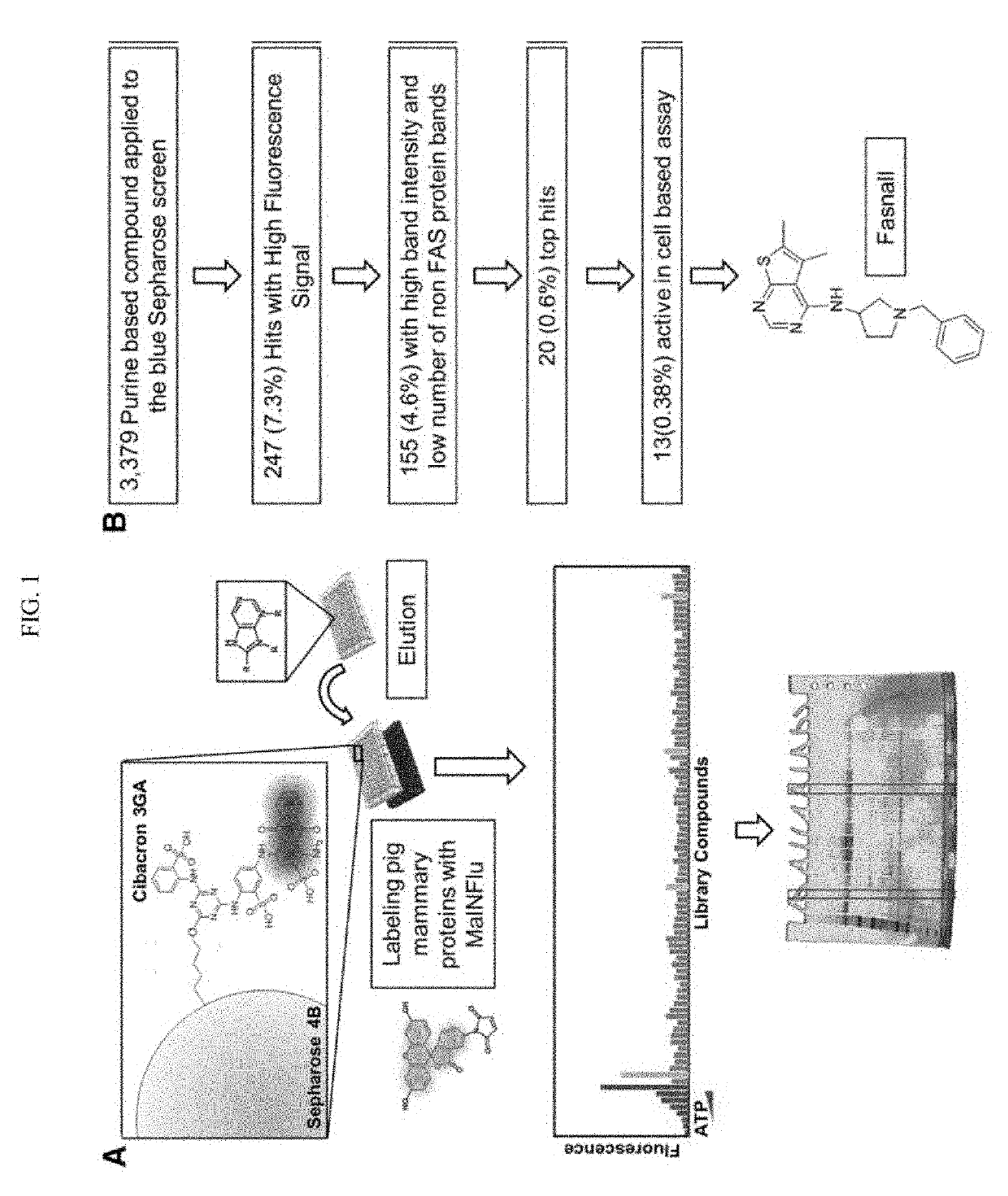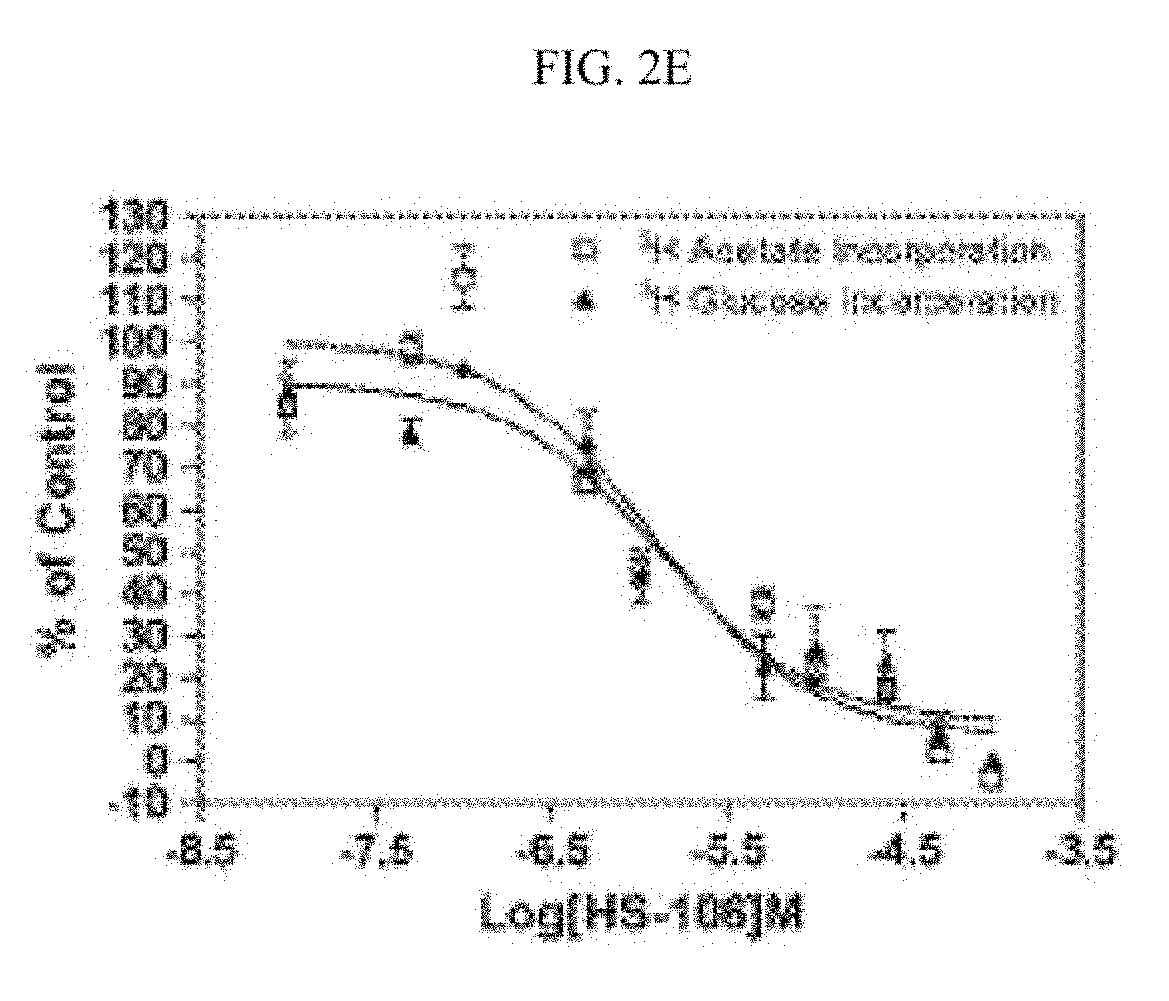Fatty acid synthase inhibitors
a fatty acid synthase and inhibitor technology, applied in the direction of organic active ingredients, heavy metal active ingredients, organic chemistry, etc., can solve the problems of increased tumor aggressiveness, poor prognostic outcome, unexpected toxicities,
- Summary
- Abstract
- Description
- Claims
- Application Information
AI Technical Summary
Benefits of technology
Problems solved by technology
Method used
Image
Examples
example 1
hibits Proliferation in Breast Cancer Cell Lines
[0114]To evaluate the potential of HS-106 in breast cancer, we first tested its effects on proliferation across a panel of non-tumorigenic (MCF10A) and aggressive tumor forming breast cancer cell lines including ER+ (MCF7), triple negative (MDA-MB-468) and HER2+ (BT474 and SKBR3). HS-106 inhibited the proliferation of aggressive cell lines with similar potency to C75, but showed lower activity in the non-tumorigenic cell line MCF10A (FIG. 4A-E). The weaker effects of HS-106 in MCF10A cells correlated with low expression of FASN in this cell line relative to the more aggressive lines, suggesting the former cells are less dependent on FASN for growth (FIG. 4G). HS-106 treatment of BT474 cells did not induce cell cycle arrest except for an increase in the Sub 2N cell population (FIG. 4F).
example 2
ters the Global Cellular Lipid Profile of BT474 Cells Consistent with Selective FASN Inhibition
[0115]To determine the effects of HS-106 on the whole cell lipid profile, we carried out lipidomic analysis by LC-MS-MS following 2 hours of exposure to 10 μM HS-106 in BT474 cells (FIG. 5). Using ESI+ and ESI− profiling, more than 3000 lipids features can be simultaneously quantified and our analysis showed that HS-106 induced more than two fold change in abundance of 167 specific molecules (p14C palmitate uptake assay where HS-106 treatment increased 14C labeling of free fatty acids (FIG. 11). Other lipids of particular note that increased many fold with HS-106 are ceramides, which are considered as pro-apoptotic lipids. The increase of ceramides would be expected due to malony-CoA (the direct substrate of FASN) accumulation and its effects on CPT-1 inhibition (Bandyopadhyay et al., 2006). As a consequence, any free fatty acids (derived primarily from the extracellular media) are likely ...
example 3
iferative Activity of HS-106 is Due to the Induction of Apoptosis
[0116]Inhibition of FASN in rapidly proliferating tumorigenic cells would be predicted to have two major effects; first, limit the oxidative capacity of the mitochondria through increasing malonyl CoA levels; second, trigger program cell death pathways via accumulation of ceramide. To investigate the latter mechanism, we examined Caspase 3 and 7 activation in response to HS-106 and C75 (FIG. 7A). Consistent with their tumorigenic capacities, SKBR3 and BT474 cells had 2 to 10 fold (respectively) higher caspase activity than MCF10A cells in response to HS-106 or C75 treatment. The ability of HS-106 to induce apoptosis was also confirmed by detecting the presence of phosphatidylserine and phosphatidylcholine on the outer leaflet of the plasma membrane using fluorescently labeled Annexin V and flow cytometry (FIG. 15A). To further confirm that HS-106 induction of apoptosis is directly related to the inhibition of FASN, we ...
PUM
| Property | Measurement | Unit |
|---|---|---|
| Acidity | aaaaa | aaaaa |
Abstract
Description
Claims
Application Information
 Login to View More
Login to View More - R&D
- Intellectual Property
- Life Sciences
- Materials
- Tech Scout
- Unparalleled Data Quality
- Higher Quality Content
- 60% Fewer Hallucinations
Browse by: Latest US Patents, China's latest patents, Technical Efficacy Thesaurus, Application Domain, Technology Topic, Popular Technical Reports.
© 2025 PatSnap. All rights reserved.Legal|Privacy policy|Modern Slavery Act Transparency Statement|Sitemap|About US| Contact US: help@patsnap.com



